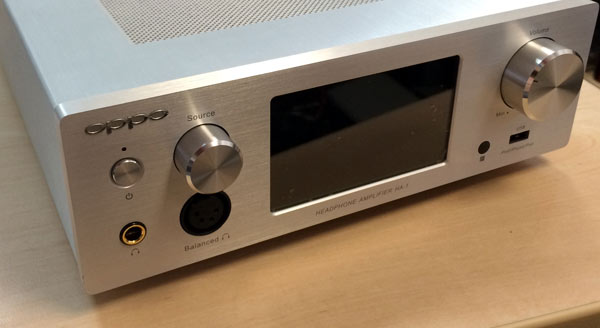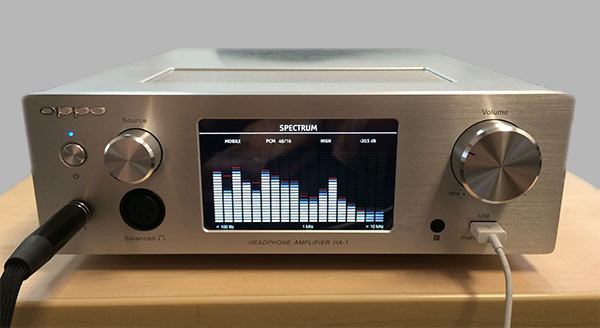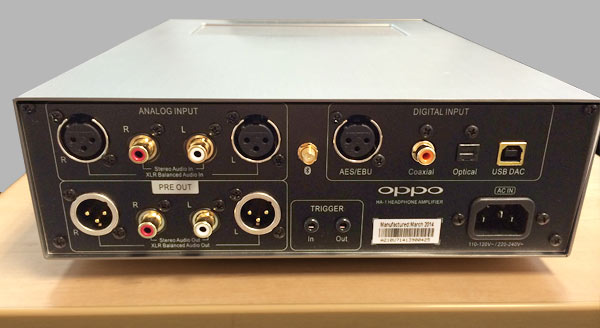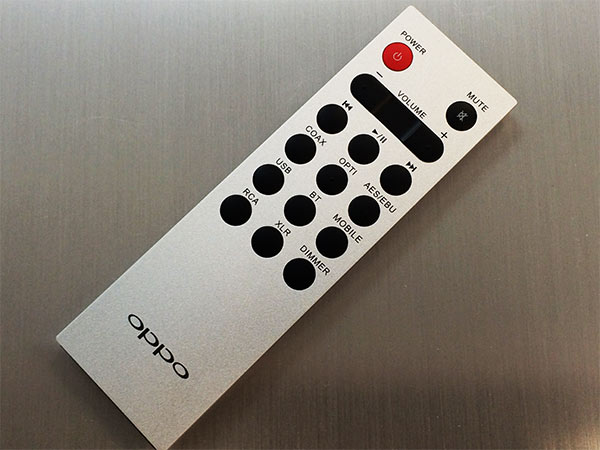Oppo Headphone Amplifier HA-1: Up Close
I’ve had the new Oppo HA-1 headphones amplifier for a few weeks now. It’s silver, substantial and sounds amazing. But is it really a “headphone amplifier” or something more? I promised to write a full review of this latest Oppo piece as soon as I’d had a chance to get acquainted with it AND to have some extended listening sessions using my Oppo PM-1 headphones. I’m ready to give you the full story.
The folks at Oppo do a great job of packaging their products. They are protected from damage in shipping with heavy-duty foam holding the unit inside. The HA-1 comes with a small remote control, a Bluetooth antenna, heavy gauge power cord and mini to quarter inch adapter.
As I stated above, the HA-1 is much more than a headphone amplifier. Of course, it does have a very high quality headphones amplifier, which goes beyond the terrific circuitry found in the BDP-105. The device also features a very flexible asynchronous USB DAC that accepts both PCM and DSD signals, balanced and unbalanced stereo inputs so you can use it as a preamplifier, USB inputs for your high-resolution portable devices (Pono or standard resolution players) and Bluetooth audio player.
The price of the HA-1 is $1199. It’s not cheap but as it does do a bunch of things at a very high level, you’d be hard pressed to find a competitive product that delivers as much.
Physical Description and I/O
The HA-1 is heavy. It weighs just less than 15 pounds. The brushed aluminum, machined front panel has a power button, two headphones output jacks (1/4″ unbalanced and 4-connector balanced headphone jacks), rotary source selector knob and display window that’s a little bigger than the size of a business card. On the right side of the main display are a large volume knob and USB “Type A” input for portable players. It’s a simple layout and doesn’t feel cluttered or crowded.
Figure 1 – The front of the Oppo HA-1 Headphones Amplifier
The back of the HA-1 is loaded with inputs and outputs starting with both balanced and unbalanced analog inputs and preamplifier outputs. There’s a couple of trigger jacks (input and output) for controlling the unit externally (custom installers take note) and the usual assortment of digital inputs including AES/EBU, S/P DIF coaxial, TOSlink optical and “Type B” USB.
Figure 2 – HA-1 back panel.
The remote is a small, thin, aluminum unit about 5 inches long. It’s bigger than the one for an Apple TV but actually feels better because it’s more substantial. The remote has power, mute, volume and allows you to select which input you want. It even includes a dimmer to lower the intensity of the main display.
Figure 3 – The Oppo HA-a remote control.
Connections
The HA-1 can be connected to your stereo system using the analog outputs. Choose either the balance XLR connectors or the unbalanced female RCA jacks.
Likewise, there are analog inputs for both XLR or RCA inputs. Any analog line level signal will be sent to the headphone and line level outputs. The input source selector allows you to choose between the XLR or RCA inputs.
You can take your pick when connecting digital devices to the HA-1. There are inputs for AES-EBU (XLR), coaxial (RCA), TOSlink (optical) and Type “B” USB digital signals. You selected between them using the remote or the input selector on the front. The main display indicates which input is active.
In addition to the digital inputs mentioned above, there is a USB Type “A” connector on the front of the unit. This can be used for connecting Apple’s “i” devices to the HA-1. Currently, it supports the iPhone 5S, iPhone 5C, iPhone 5, iPhone 4S, iPad (4th Gen), iPad mini and iPod (5th Gen). If you’ve got an Apple product, the HA-1 is all set to go. If you’re using a Smartphone from another manufacturer, you’re out of luck. I’ll have to ask the Oppo folks whether they plan to support of the phones/players.
For those of you using Bluetooth-capable mobile devices, the HA-1 can “pair” with them as well as wired equipment. The entire line of Apple devices is compatible and any device or computer that supports the Bluetooth A2DP protocol.
Operation
I first got my hands on the new Oppo HA-1 at the recent AXPONA 2014 show in Chicago. Apparently, the first shipment of units had just arrived at their headquarter in Mountain View and they asked if I would be willing to display the unit at my sales table in Chicago. Of course, I agreed.
I set the unit up on the corner of our booth, plugged the S/P DIF output of the Oppo BDP-83 into the coaxial input of the HA-1, turned the unit on, selected coax as the input and presto…my Oppo PM-1 planar magnetic phones began to sing. I didn’t really appreciate what was happening at the sales table because I was busy giving demos inside the Madison Ballroom but I know that plenty of customers came by and checked it out.
There were a couple of times that someone had dialed up a different input or changed the display, which stopped the music. It’s either a credit to the designers or my own ability to figure things out, but I managed to get the HA-1 back on track in no time at all…and I hadn’t yet opened the manual. It’s really not that complicated.
Once the power is turned on, there is a tiny blue indicator above the switch that glows. All you have to do is select your desired input using the SOURCE knob, which causes a highlight to move through the 8 different inputs on the main display. You can use the controls on the front or on the remote to switch inputs and adjust the volume.
The main display area is multifunctional. It shows the input choices when you spin the SOURCE knob or a circular volume graphic when you turn the volume up or down. It can also display the STATUS, SPECTRUM or act as a VU METER (with a set of stereo classic analog style meters) depending on what’s happening and your preferences. You can set the “Home Screen Selection” preference by pushing the SOURCE knob in and selecting among the three choices.
The STATUS is displayed on the main window. It tells you what source is active, the audio type (format, sample rate and word length), gain level (you have the choice between HIGH and LOW to accommodate all types of phones) and the current volume setting.
I would have loved the SPECTRUM choice to include segments above the >10 kHz maximum but this is my affliction and not the concern of the designers at Oppo. My favorite Home Screen is the vintage analog VU meters…they remind of so many machines I’ve had in the past…and the “Modulometer” on my Nagra reel to reel machine.
The other operational choices are the DIMMER and the MUTE buttons. There are three different display light levels from bright, medium and off. The mute works as expected.
Finally, the HA-1 has a “Home Theater Bypass Mode”, which a clever feature that makes sure the HA-1 plays nice with any system you’re likely to encounter. Each of the inputs can have this bypass feature turned on or off. When it’s turned on the VOLUME knob is set at unity gain and become inoperable. You don’t want to have to chase the amplitude in your system in two places…the HA-1 AND the volume on your A/V Receiver.
Tomorrow, I will talk about the performance of the HA-1. I’ve played a variety of material through it from analog and digital sources in standard definition and high-resolution.





Thanks, Mark. One question, one comment. Why not just use the Oppo as a DAC? What the comparison, if you can say, between the Oppo and Benchmark?
Comment: if you want to see the state of confusion and ignorance about digital music, head on over to Audiogon and read the comments on an offering of – can I say it here, Mark – an “hd”tracks sampler.. Mind you this isn’t an iTunes forum or some earbuds love fest. This is Audiogon, whose traffic one would suppose, is mainly seasoned audiophiles.